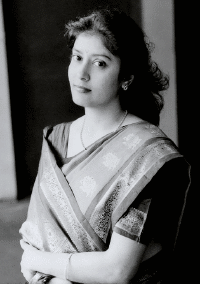| Lifting the Curtain of Concealment | |
| by Indu Sundaresan | |
 It is somewhat incredible for women of today, with our modern 21st-century sensibilities, to comprehend the concept of a harem as it existed during the Mughal Empire in India. The word harem (from the Arabic haram, or "forbidden") conjures up voluptuous notions of fantastic wealth and indulgence. Of barely clad beautiful women lounging on silk divans, seen through the gentle whorling smoke of a water pipe. Of slaves who obey every bidding, of jewels of unimaginable luster resting on skins radiant with turmeric and sandalwood. The surviving harem rooms at the palaces at Delhi and Agra do little to dispel these images. Within are ceilings tiled in turquoise, fountains of marble etched in the shape of lotus flowers, delicately carved sandstone balcony supports, and symmetric ponds spanned by stone bridges. Let imagination bolt in these sumptuous spaces and the sound of centuries-old laughter echoes softly, or fragrant jasmines thread the soot-black hair of languorous women, or the now-dry stone baths conjure visions of steam and glowing skin.
It is somewhat incredible for women of today, with our modern 21st-century sensibilities, to comprehend the concept of a harem as it existed during the Mughal Empire in India. The word harem (from the Arabic haram, or "forbidden") conjures up voluptuous notions of fantastic wealth and indulgence. Of barely clad beautiful women lounging on silk divans, seen through the gentle whorling smoke of a water pipe. Of slaves who obey every bidding, of jewels of unimaginable luster resting on skins radiant with turmeric and sandalwood. The surviving harem rooms at the palaces at Delhi and Agra do little to dispel these images. Within are ceilings tiled in turquoise, fountains of marble etched in the shape of lotus flowers, delicately carved sandstone balcony supports, and symmetric ponds spanned by stone bridges. Let imagination bolt in these sumptuous spaces and the sound of centuries-old laughter echoes softly, or fragrant jasmines thread the soot-black hair of languorous women, or the now-dry stone baths conjure visions of steam and glowing skin.
 Despite their opulent surroundings, memoirs and manuscripts written during the 16th and 17th centuries show harem women being as accomplished, intelligent, and complex as the women of today.
Despite their opulent surroundings, memoirs and manuscripts written during the 16th and 17th centuries show harem women being as accomplished, intelligent, and complex as the women of today.
They learned the classics in Persian and Sanskrit, and had tutors in astronomy, math and logic. They owned ships that plied the Arabian Sea routes. They had vast incomes and appointed stewards to oversee their lands. They wrote poetry, samples of which still exist. They hunted using muskets and matchlocks, precariously perched on litters strapped on the backs of elephants.
These were allowed, and sometimes expected roles the women had to fulfill. A choice few stepped beyond these expectations, only to be cast in history's gaze as sly, malicious and conniving.
Empress Nur Jahan was one.
Born as Mehrunnisa (the Sun of Women), she was Emperor Jahangir's twentieth wife. Almost from the beginning of her royal life, Mehrunnisa fit none of the established norms of womanhood in 17th-century India. Jahangir's 19 other marriages had all been contracted for political reasons -- Mehrunnisa was the first woman he married for love. In a time when a woman's importance literally came from being young and fertile, Mehrunnisa married Jahangir at the "old" age of 34. She gave him no heirs; in fact, she gave him no children. Yet he loved her so deeply and obsessively that he transferred his powers of sovereignty to her. By the time he died, Mehrunnisa had coins minted in her name and issued royal edicts. She, a woman behind a veil, was during the 17th century the ruler of India's Mughal Empire -- in all but name.
My first novel, The Twentieth Wife, is Mehrunnisa's story before she becomes empress. It is the story of a deep and enduring love between Emperor Jahangir and Mehrunnisa that leads them to eventually marry in 1611. It is the story of the sometimes terrible circumstances that influence Mehrunnisa's life, that would have vanquished a weaker woman, but prepare her for the biggest role she will eventually play -- that of the most powerful woman in Mughal, India.
Indu Sundaresan was born and brought up in India. She came to the United States for graduate studies and started writing fiction seriously in 1993. Her work has appeared in The Vincent Brothers Review and on the iVillage.com website. She has worked with a local theatre for the last five years building and painting sets, and writing program notes and teachers' packets. Indu and her husband live in Bellevue, Washington. Her website is here.
Indu is currently at work on the sequel to The Twentieth Wife, titled Power Behind the Veil, which will continue Mehrunnisa's story as Empress Nur Jahan until the time of her death.
Author photo courtesy of InduSundaresan.com
